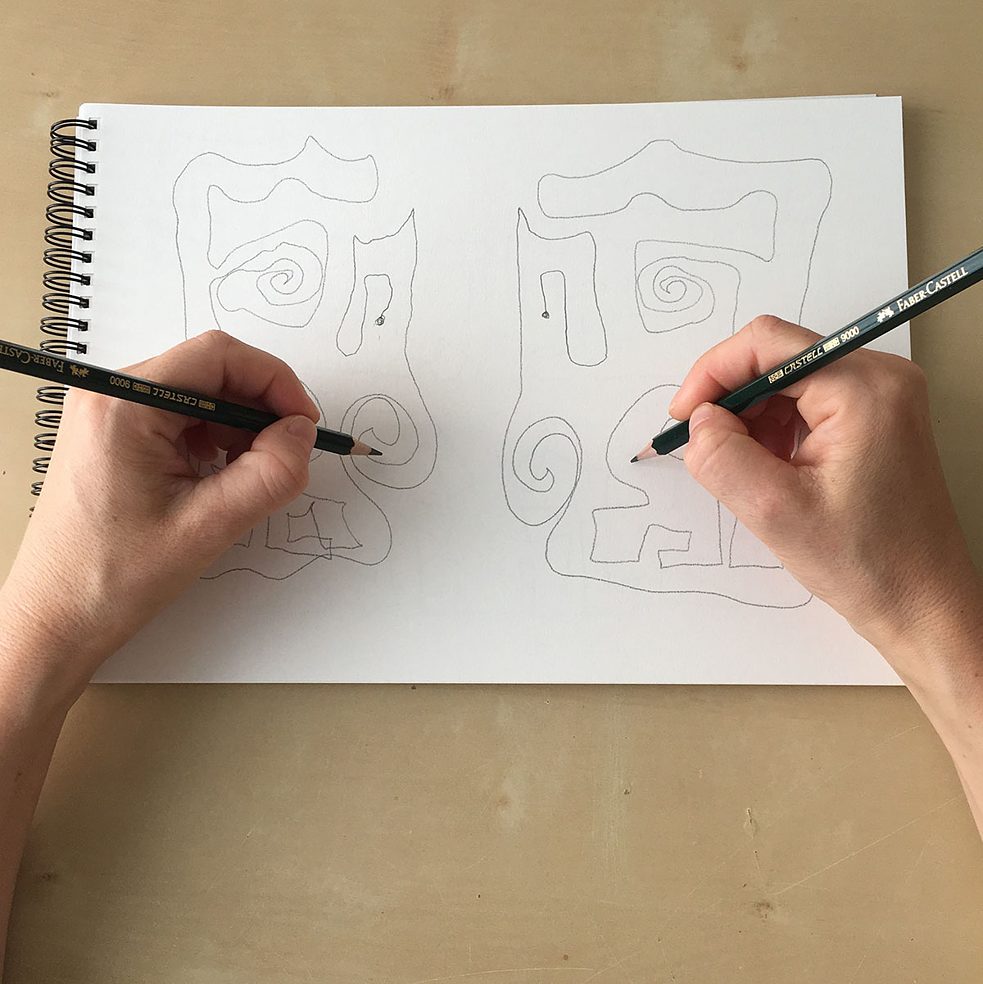With all senses
 Silke Wittig | CC BY-NC-SA 4.0
YOU WILL NEED:
Silke Wittig | CC BY-NC-SA 4.0
YOU WILL NEED:
- A4 paper
- pencils
- clipboard
- crepe masking tape
- brown paper
- scissors
- ball of wool
- finger paints
INSTRUCTIONS
These brief exercises serve to train the senses in perceiving space and surroundings. They are based on tasks from the Bauhaus preliminary course and the teaching in the workshops. They can be used as a module in their own right, or as a warm-up to begin a session.
EXERCISE 1: SEE, FEEL, DRAW
This partner exercise trains the sensory perception.Step 1: Both partners have paper and pencil, partner 1 also has a clipboard.
Step 2: Partner 2 is shown photos of Bauhaus buildings, and chooses one to draw. The paper is placed on Partner 1’s back and attached with crepe masking tape. Partner 2 sketches the building onto the paper on partner 1’s back.
Step 3: Partner 1 “copies” the lines they feel on their back onto their own sheet of paper. Partner 1 should not look at the original but concentrate on feeling the lines being drawn.
Step 4: Finally the two drawings are compared. Can a resemblance be detected? Then the partners swap roles.
Option: This exercise can also be used on urban excursions in connection with prominent buildings.
EXERCISE 2: PERCEPTION OF BODY AND SPACE
This exercise concerns the perception of space through body and movement, and their transposition into lines, outlines and figures. This is a group exercise done in pairs.Step 1: The participants begin by moving in space for a few minutes, making sure they use as much of the space as possible.
Step 2: Now large pieces of brown paper are laid out in the middle of the room, one piece per pair. Partner 1 lies on the paper in a chosen pose, partner 2 draws round their outline with a pencil.
Step 3: Now partner 1 moves to a new position, and again partner 2 draws round the outline. This is repeated several times, superimposing a series of outlines on the paper.
Step 4: Now the partners swap roles and repeat the exercise.
Step 5: Now the sheets of paper are hung on the walls. What impression do the outlines make? To they look like figures in motion? How do they relate to the space?
EXERCISE 3: LINES AND STRUCTURES WITH WOOL
This exercise is done in groups of five to ten participants. It concerns a comparison of two-dimensional and spatial structures.Step 1: The participants form a circle. One participant is given a ball of wool and ties the loose end to their hand.
Step 2: Now the ball of wool is thrown to another participant, so that the thread of wool connects the two. The second person keeps a hold of the thread and throws the ball on.
Step 3: Once all the participants have received the ball of wool at least once, they stop and examine the structure they have created. What does the figure look like? Does it resemble anything?
Step 4: Now the participants lay wool structure on the floor and examine the form again. What has changed? Does the flat structure appear different from the spatial one?
EXERCISE 4: DRAWING TWO-HANDED
This exercise involves drawing with both hands at the same time. The point is to playfully explore the act of drawing and to focus on the process rather than the result.Step 1: Take a pencil in each hand and place both on the paper. Try to draw identical lines and patterns using synchronous movements.
Step 2: When everybody is ready, the group views the pictures. What kind of lines, shapes and patterns have been drawn? Are the results symmetrical? Which side is better? This exercise offers a nice surprise, when the participants discover that they really can draw with both hands.
EXERCISE 5: “A LINE IS A DOT THAT WENT FOR A WALK” – PAUL KLEE
This exercise trains the sensory perception and reduces inhibitions against expressing oneself artistically.Step 1: The participants choose the finger paint colour they like best. Then they put a dot on their drawing paper and let their finger wander over the paper to create a line – as if the dot was “going for a walk”.
Step 2: Now they choose another colour and either continue the existing line or start a new one.
Step 3: When everybody is ready, the group views the pictures. What kind of lines, shapes and patterns


